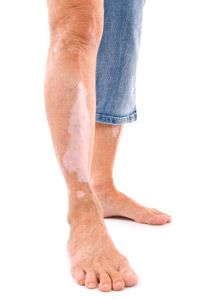If you discover a discolored patch of skin on your body, should you be worried? With skin cancer awareness on the rise, it's good to be vigilant, but you don't want to fret over every little mole or patch. Being informed can help you figure out what's going on and how to proceed.
First, you need to know how your skin gets its normal color. The top layer of your skin, called the epidermis, contains cells called melanocytes, which produce the pigment melanin when you're exposed to the sun. Melanin has many functions, one of which is to help block ultraviolet rays. When you tan and your skin turns brown, that's the melanin working to protect the layers of your skin.
Advertisement
Even though your skin (and melanin) covers your whole body, sometimes skin can be discolored in seemingly random places. It can be widespread or limited to a specific spot. Widespread discoloration is often referred to as generalized. When the discoloration appears on just one side, it's called segmental, because it's affecting only one part of your body. Focal discoloration happens when you have discoloration in one or just a few places [source: Mayo Clinic]. Also, the affected skin might be hyperpigmented (darker than normal) or hypopigmented (lighter than normal) [source: U.S. National Library of Medicine].
If you notice your skin is discolored, whether it's generalized, segmental or focal, your next step is to consider whether you should see a doctor.
Ask yourself these questions:
- Can I explain the discoloration? For example, if you've recently been tanning and didn't apply your sunblock evenly, that could cause a strange discoloration and probably wouldn't be a reason to be concerned. But if you've got odd splotches that won't go away and that you can't account for, you might want to consult a doctor.
- Is the discoloration changing? Changes in shape, size and color can be warning signs of skin cancer, so getting checked is a good idea [source: American Academy of Dermatology].
The bottom line is that if you're worried, visit your doctor. Be prepared to give your doctor information, such as when the discoloration started, how long it's been going on and whether it is spreading or changing [source: U.S. National Library of Medicine].
What can cause skin discoloration in the first place? Read on to find out.
Advertisement


